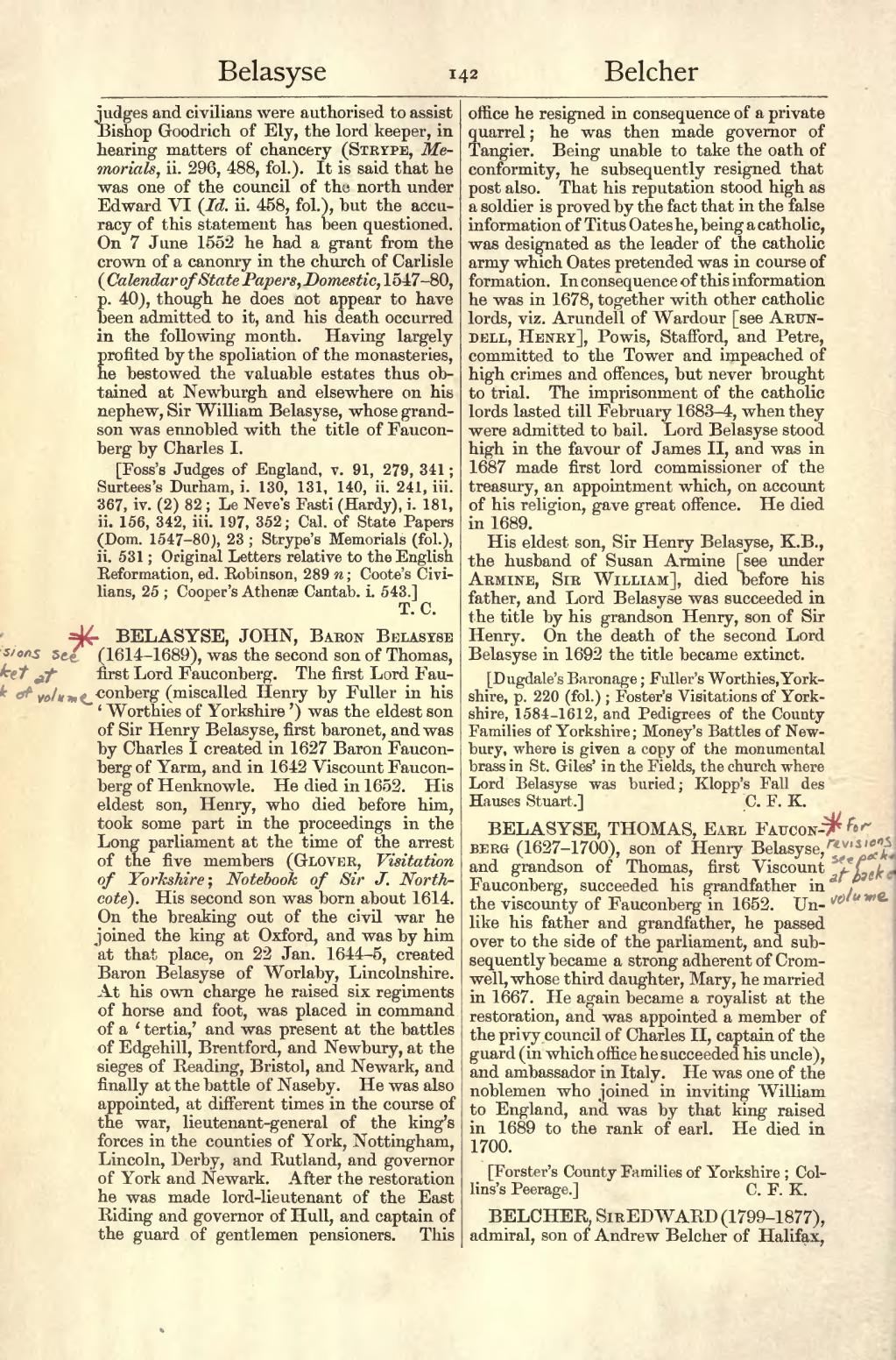judges and civilians were authorised to assist Bishop Goodrich of Ely, the lord keeper, in hearing matters of chancery (Strype, Memorials, ii. 296, 488, fol.). It is said that he was one of the council of the north under Edward VI (Id. ii. 458, fol.), but the accuracy of this statement has been questioned. On 7 June 1552 he had a grant from the crown of a canonry in the church of Carlisle (Calendar of State Papers, Domestic, 1547-80, p.40), though he does not appear to have to admitted to it, and his death occurred in the following month. Having largely profited by the spoliation of the monasteries, he bestowed the valuable estates thus obtained at Newburgh and elsewhere on his nephew, Sir William Belasyse, whose grandson was ennobled with the title of Fauconberg by Charles I.
[Foss's Judges of England, v. 91, 279, 341; Surtees's Durham, i. 130, 131, 140, ii. 241, iii. 367, iv. (2) 82; Le Neve's Fasti (Hardy), i. 181, ii. 156, 342, iii. 197, 352; Cal. of State Papers (Dom. 1547-80), 23; Strype's Memorials (fol.), ii. 531; Original Letters relative to the English Reformation, ed. Robinson, 289 n; Coote's Civilians, 25; Cooper's Athenæ Cantab, i. 543.]
BELASYSE, JOHN, Baron Belasyse (1614–1689), was the second son of Thomas, first Lord Fauconberg. The first Lord Fauconberg (miscalled Henry by Fuller in his 'Worthies of Yorkshire') was the eldest son of Sir Henry Belasyse, first baronet, and was by Charles I created in 1627 Baron Fauconberg of Yarm, and in 1642 Viscount Fauconberg of Henknowle. He died in 1652. His eldest son, Henry, who died before him, took some part in the proceedings in the Long parliament at the time of the arrest of the five members (Glover, Visitation of Yorkshire; Notebook of Sir J. Northcote). His second son was born about 1614.
On the breaking out of the civil war he joined the king at Oxford, and was by him at that place, on 22 Jan. 1644-5, created Baron Belasyse of Worlaby, Lincolnshire. At his own charge he raised six regiments of horse and foot, was placed in command of a 'tertia' and was present at the battles of Edgehill, Brentford, and Newbury, at the sieges of Reading, Bristol, and Newark, and finally at the battle of Naseby. He was also appointed, at different times in the course of the war, lieutenant-general of the king's forces in the counties of York, Nottingham, Lincoln, Derby, and Rutland, and governor of York and Newark. After the restoration he was made lord-lieutenant of the East Riding and governor of Hull, and captain of the guard of gentlemen pensioners. This office he resigned in consequence of a private quarrel; he was then made governor of Tangier. Being unable to take the oath of conformity, he subsequently resigned that post also. That his reputation stood high as a soldier is proved by the fact that in the false information of Titus Oates he, being a catholic, was designated as the leader of the catholic army which Oates pretended was in course of formation. In consequence of this information he was in 1678, together with other catholic lords, viz. Arundell of Wardour [see Arundell, Henry], Powis, Stafford, and Petre, committed to the Tower and impeached of high crimes and offences, but never brought to trial. The imprisonment of the catholic lords lasted till February 1683-4, when they were admitted to bail. Lord Belasyse stood high in the favour of James II, and was in 1687 made first lord commissioner of the treasury, an appointment which, on account of his religion, gave great offence. He died in 1689.
His eldest son, Sir Henry Belasyse, K.B., the husband of Susan Armine [see under Armine, Sir William], died before his father, and Lord Belasyse was succeeded in the title by his grandson Henry, son of Sir Henry. On the death of the second Lord Belasyse in 1692 the title became extinct.
[Dugdale's Baronage; Fuller's Worthies, Yorkshire, p. 220 (fol.); Foster's Visitations of Yorkshire, 1584-1612, and Pedigrees of the County Families of Yorkshire; Money's Battles of Newbury, where is given a copy of the monumental brass in St. Giles' in the Fields, the church where Lord Belasyse was buried; Klopp's Fall des Hauses Stuart.]
BELASYSE, THOMAS, Earl Fauconberg (1627–1700), son of Henry Belasyse, and grandson of Thomas, first Viscount Fauconberg, succeeded his grandfather in the viscounty of Fauconberg in 1652. Unlike his father and grandfather, he passed over to the side of the parliament, and subsequently became a strong adherent of Cromwell, whose third daughter, Mary, he married in 1667. He again became a royalist at the restoration, and was appointed a member of the privy council of Charles II, captain of the guard (in which office he succeeded his uncle), and ambassador in Italy. He was one of the noblemen who joined in inviting William to England, and was by that king raised in 1689 to the rank of earl. He died in 1700.
[Forster's County Families of Yorkshire; Collins's Peerage.]
BELCHER, Sir EDWARD (1799–1877), admiral, son of Andrew Belcher of Halifax,
